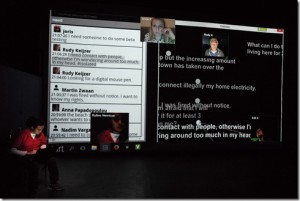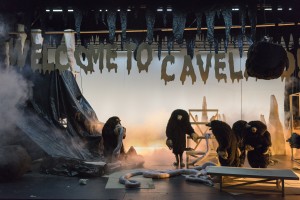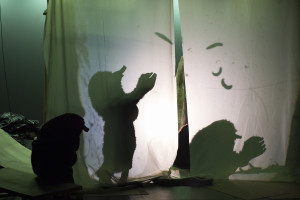Creating Communities – Reflecting New Europe: “La nuit des taupes” (Welcome to Caveland) and “Web of Trust” presented at the Kunstenfestivaldesarts, Brussels.

Kunstenfestivaldesarts in Brussels: “La nuit des taupes” (Welcome to Caveland!) by Philippe Quesne (Nanterre-Amandiers – centre dramatique national) and “Web of Trust” by Edit Kaldor (Stichting Kata, Amsterdam).
Reporting from a theatre festival is a special task. Often a reviewer watches two or three shows in one day, participates in discussions, meets friends and students. The work is hectic. Still the thinking must be done and the critical opinion proposed.
In the following, I provide some observations on two productions I saw in Brussels on May 8, 2016. Although La nuit des taupes (Welcome to Caveland!) by Philippe Quesne and Web of Trust by Edit Kaldor are radically different in their performative styles, they share a specific concern, something that I see more as a unifying-thread in the 2016 edition of Kunstenfestivaldesarts.
This concern has to do with the way today’s Europe, and by extension the rest of the world, deals with two leading social tendencies. One is about expansion, globalization, increased mobility, and people working across the borders; another has to do with our fear of home-grown terrorism, civil wars, and mass migration. Many productions share these concerns. Many artists, either of immigrant background or not, define their work as transgressing geographical, social and artistic borders.
In La nuit des taupes (Welcome to Caveland!) Philippe Quesne, a guest of honour at the Kunstenfestivaldesarts, proposes an allegorical take on these issues. Following his previous experiments in Swamp Club, this time he brings on stage nine gigantic moles. Their world has been threatened by some unknown cause, perhaps an invasion of some sort, and now they must seek refuge elsewhere. The moles are blind but harmless creatures. They like to work, eat, have sex and listen to music, so they need to reconstruct the world they lost. In this 2 hour, wordless production, Quesne manages to tell the story of the making of Western civilization. On stage, there is a huge box made of cartoon panels, through which the moles laboriously make their entry into the new world, or rather a new cave. They are very serious, devoted to the task, and extremely charming. The actors wear gigantic plush costumes (designed by Corine Petitpierre and assisted by Anne Tesson) that make their characters clumsy but very sympathetic, somewhat reminiscent of the big fluffy creatures walking on the streets of New York at Christmas time. It is a simple but fair community to which many would like to belong. Simple needs and rules govern this world – work is done religiously, food is worshipped, sex is performed dutifully, babies are cherished, and the dead are properly mourned. Happiness reigns.
Plato’s Allegory of the Cave, a conversation between Socrates and his student Glaucon, is the major inspiration for this production. In the dialogue, Socrates invites Glaucon to imagine a cave, with the prisoners who have been kept there since their childhood. The prisoners are forced to stare at a wall in front of them, onto which the images of humans and animals are projected. They cannot move their gaze and so assume that the images they see are real, not shadowy representations of reality.

Photo: Martin Argyroglo
Similarly, in La nuit des taupe, Quesne comments on the power of an artistic image when it is used to create a community and its dangers when it is employed to control it. Two moles, obviously the leaders of the clan, bring forward a gigantic plastic curtain onto which the images of the horrible history of the above-ground world are projected. Puddles of blood, the destruction of another cave, and the shadows of moles fighting and killing each other are evoked to educate the community. Much like in Plato’s dialogue, the images construct the history and remind the moles to cherish their present. The puppeteers, the artists/leaders, control this storytelling journey.
In Plato’s allegory, Socrates contemplates what would happen if one of the prisoners was given a chance to turn around and see the fire, to understand that what the prisoners have been shown is not reality, only its shadow. What if, Socrates asks, this prisoner was given a chance to leave the cave, see the world and come back home. His obligation, Socrates explains, would be to educate his fellow prisoners, to explain the difference between reality and its image, even if he now feels estranged from his group. Raising prisoners’ awareness might lead them to question their existence, something that in the world of social experiment or utopia, would be equal to a revolt.
In Quesne’s production, there is no mole/prisoner/outsider who dares to leave the cave. The show ends with a rock-concert: the mole-musicians are on the far right having a go at their instruments; while others join them in the ecstasy of performing, listening to music. Life goes on, music plays, lights flicker, smoke drifts on: an image of happiness.
In this playful manner however, Quesne returns to the core of the philosophical issues raised in Plato’s dialogue and later in the works of science fiction. He asks us to rethink the premise of Plato’s thinking, his criticism of the power of artistic expression, which can instigate the working of the imagination. Quesne also asks us to contemplate the authority of the community, which can simultaneously support and control its members. The production means to tell us – although somewhat ironically – that seeking asylum elsewhere can only be a temporary solution. And even if the leaders continue telling their creepy tales, at some point their subjects will revolt. For now, they are perfectly content, moving in unison with the bits of the rock music, but soon they will decide to check for themselves the truth of the projected image.
La nuit des taupes is the first (theatre) part of the larger project Philippe Quesne has proposed for the festival. The second part is an interactive project, a specially designed performance space, in which several artists are invited to create their own versions of the Caveland during the festival.

Edit Kaldor’s Web of Trust that I saw on the same night can be taken as an indirect response to La nuit des taupes. Here, we’re presented with the so called “real” or “true” realities of today’s world, as these realities are imagined and shaped by the users of the internet chat-rooms. A Hungarian born, US raised, and currently living in Amsterdam performance artist, Edit Kaldor has been exploring the potential of cyber space to create its own cosmopolitan communities for the past decade. In the project she brought to the festival, we meet a number of participants of Kaldor’s international research group who reside across Europe. The objective is to prove that internet has its own life-pace and rules, and whether we want it or not, we all participate in this form of communal living.
Here, we find as well, the echoing of Plato’s allegory. The chat room run by Kaldor and her collaborators, has very specific goals: it is designed to connect people who can freely express and share their needs, and who can collectively help each other. However, the false sense of being connected and hence dealing with true reality not its image, hoovers over the project, perhaps, somewhat against the creators’ intentions.
The show takes place in the tiny performance space of the Theatre de la Vie, an off Brussels’ historical centre. As we enter the room and take our seats, Kaldor and her assistant are already seated at tiny tables on stage. The screen is up and onto it we see projected the messages and the faces of the other participants who are currently on line. Stylistically this performance mixes the devices of verbatim theatre, participatory and durational performance. The first part lasts about 45 minutes, during which the rules of Kaldor’s chat-room are set and the major players/internet personalities/ are introduced. The next part is durational and participatory: those who wish so can join the network and try to chat with the participants online; others should feel free to leave the performance space, have a beer and return to the room to observe how the situation unfolds. On Sunday night, many spectators left the performance right away, some stayed for beer and wine. I decided to accept the artists’ invitation and join them online. I was asked to invent a username, provide a password and submit either my need or my skill, something that other people could use either to communicate with each other or as some sort of practical device. Since I did not have any urgent need to share – some participants really had it hard with one telling us of her suffering from a severe depression, another being attacked by his landlord and his apartment set on fire, a third reporting from a refugee camp in Netherlands and the increased surveillance instigated by the authorities looking for any reason to deport people back to their countries — I decided to offer my “skill.” In the context of an international festival, I thought I would offer my help in translation, assisting someone in communicating his or her need in English, French or Russian. Unfortunately, during my 30 minutes involvement with this performance, nobody demanded my skills or wanted to chat. So, I joined the others at the bar and eventually left.
In fact, I feel sad that this very promising initiative was not better structured nor brought more concrete and immediate results. Perhaps, it accidentally fell into the trap of any participatory work that relies too much on the audience’s enthusiasm. Perhaps, the creators overestimated their projected audience’s interest in the internet chat-rooms; at the end we do come to live theatre to have a chance for a personal encounter with another human being. What I think happened in that performance hall is that the production team did not spend enough energy to build a proper community of theatregoers who eagerly came to learn more about the new realisms of virtual life in cyber space. For a theatre performance, durational, participatory, immersive, or otherwise, it remains important to create a strong emotional and intellectual bond between the stage and the audience, before asking us to jump into making community – in life, on stage, or in virtual reality.
The potential of such performative endeavour was truly invigorating. Not only it promised a rich connection to Plato’s contemplation on the difference between reality and its representation; it had a chance to comment on how today’s cosmopolitan communities are formed and invited us to think further on how we could better articulate ourselves across borders.
In fact, both productions were very clear in spelling out the rules of communication that forming such a community demanded: anyone can become a participant. What we need to do is to be able to articulate our needs, seek other people dealing with similar issues, find a solution together, and provide assistance to each other. These are the same rules of a supportive and reliable community, either created by Philippe Quesne for his moles or made by internet users. However, if such a community were ruled by skilled, powerful and somewhat dangerous storytellers, the results might be quite different.
CREDITS:
La nuit des taupes (Welcome to Caveland!) featuring Yvan Clédat, Jean-Charles Dumay, Léo Gobin, Erwan Ha Kyoon Larcher, Sébastien Jacobs, Thomas Suire, Gaëtan Vourc’h; Costumes by Corine Petitpierre and assisted by Anne Tesson; Dramaturgy Léo Gobin, Lancelot Hamelin, Ismael Jude, Smaranda Olcese
Web of Trust – Concept Edit Kaldor; Made in collaboration with Gigi Argyropoulou, Lisa Skwirblies, Bojan Djordjev, Jurrien van Rheenen, Joris Favié, Nele Beinborn, Rufino Henricus, Martin Kaffarnik, Oleg Myrzak, Meike Jansen, Giorgi M., Ivo de Kler, Rudy Keijzer, Aleksandra Jarocka, Nele Beinborn, Velvet Leigh, Michel Bezem, Jana Mendelski, Ivo de Kler, Tirza Gevers, Rodrigue Peguy, Richard Djif, Alexander Nagel, Sylvain Vriens, Koen Berghmans, Juliette Vrancken, Myriam Mezghad, Agnès Ader, Elke Gutiérrez, Gert Bouquiaux, Marollywood, Woningen 123 Logements, Pierre Olivier Perret and many others.